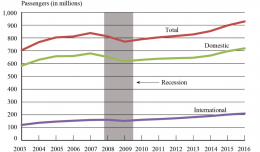The European travel chaos as a result of volcanic ash from a volcano in Iceland came to an end on Thursday as all affected airspace was re-opened.

The ash plume came from Grímsvötn, Iceland’s most active volcano, which erupted on late Saturday afternoon and spread an ash cloud over some parts of Europe. The chaos was significantly less severe than last year when ash from the Eyjafjallajökull volcano grounded flights across Europe.
From Monday through Wednesday, more than 900 flights were canceled in Iceland, Ireland, Greenland, Germany, and several other countries. A number of other flights were also canceled in Iceland on Sunday.
Chaos was limited this year mainly because of new aviation rules which allow airlines to operate in areas of low and medium density ash clouds, something which was not possible when the Eyjafjallajökull volcano erupted.
“According to the Volcanic Ash Advisory Centre (VAAC) in London, there are still some limited areas of ash concentration across Europe,” Eurocontrol, the agency charged with coordinating air traffic management across Europe, said on Thursday. “However, these are expected to have very little or no impact on European air traffic in the coming 48 hours. No airspace is currently closed due to volcanic ash.”
Some airlines and aviation organizations have argued against the restrictions for volcanic ash, most notably Irish low-cost airline Ryanair. “Ryanair strongly objects to this decision and believe that there is no basis for these flight cancellations,” it said in a statement this week, calling the volcanic ash ‘another misguided invention’ by authorities.
But aviation experts disagree, saying that the volcanic ash can result in an aircraft losing its engines. In 1982 and 1989, two Boeing aircraft lost all their engines when flying through a thick cloud of volcanic ash. The planes were able to land safely.
The Grímsvötn Volcano is situated about 220 kilometers (136 miles) east-northeast of the country’s capital Reykjavik and is located underneath Vatnajökull, Europe’s largest glacier. Eruptions at Grímsvötn are frequent and usually occur with an interval of a few years. Most of these eruptions last a few days and are small in volume.
Historical and geological records show that there have been around 60 to 70 volcanic eruptions over the last eight centuries in the Grímsvötn volcano. The latest eruptions occurred in the years 2004, 1998, 1996, 1983 and 1934. None of these eruptions threatened lives or inhabited areas and all except one are classified as minor eruptions.
Typical eruptions at Grímsvötn last from two to fourteen days and little or limited volcanic ash is associated with these eruptions. Visible volcanic ash rarely reaches farther than the perimeter of the glacier Vatnajökull and effects on commercial air-traffic is usually limited. During the eruption in 2004, restrictions were put on air-traffic to the north of Iceland for five days and trans-Atlantic flights were re-routed to the south of Iceland. No airport closures were in effect.
The volcanic activity in the Grímsvötn volcanic system is periodic, officials say, and active periods last from about 100 to 150 years with more restful periods of a few decades in between. A period of increased activity seems to have started with the eruption in 1983.






